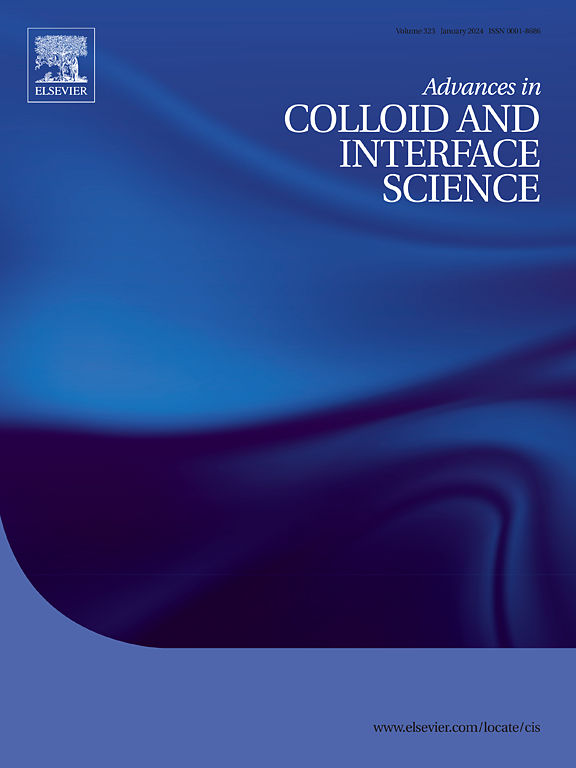生物基材料在二氧化碳地质利用与封存过程中调控多相系统界面行为的研究进展
IF 19.3
1区 化学
Q1 CHEMISTRY, PHYSICAL
引用次数: 0
摘要
CO 2的地质利用和储存涉及复杂的多相界面行为,对整体效率有显著影响。近年来,生物基材料因其结构的多样性、丰度和环境相容性,作为界面调控的有前景的候选材料而受到越来越多的关注。本文综述了近年来利用生物质材料调控地下多相系统界面行为的研究进展。讨论了典型场景下界面行为与CO₂利用和固存的关系。系统地综述了生物基材料的分子结构、官能团特征和环境相容性。本文重点介绍了生物基分子在液/液、固/液、气/液界面上的吸附行为、界面分子的排列和分布以及自发自组装行为。进一步分析了这些材料对界面张力(IFT)、润湿性和毛细管力等关键界面性能的影响。本研究还探讨了一些动态界面现象,如多层囊泡结构的形成加速了相间的传质,纳米颗粒和小生物分子在静电力作用下的固液界面协同相互作用,以及生物基材料通过提供额外的吸附位点来促进CO₂的转移。这些见解为理解界面传质提供了新的视角。最后,综述了生物基材料多相界面行为调控研究的未来发展趋势,强调了原位微观表征技术的必要性,以支持其在CO 2地质利用和储存中的有效应用。本文章由计算机程序翻译,如有差异,请以英文原文为准。

Bio-based materials regulating interfacial behavior of multiphase systems during CO2 geological utilization and storage: A review
CO₂ geological utilization and storage involve complex multiphase interfacial behaviors that significantly influence the overall efficiency. Recently, bio-based materials have attracted increasing attention as promising candidates for interfacial regulation owing to their structural diversity, abundance, and environmental compatibility. This review summarizes recent advances in utilizing biomass-derived materials to regulate interfacial behaviors in subsurface multiphase systems. The relationship between interfacial behaviors and CO₂ utilization and sequestration is discussed under typical scenarios. Molecular structures, functional group characteristics, and environmental compatibility of bio-based materials are systematically reviewed. This article highlights the adsorption behaviors of bio-based molecules at liquid/liquid, solid/liquid, and gas/liquid interfaces, interfacial molecular arrangement and distribution, and spontaneous self-assembly behaviors. Effects of these materials on key interfacial properties including interfacial tension (IFT), wettability, and capillary forces are further analyzed. This study also examines some dynamic interfacial phenomena, such as the formation of multilamellar vesicle structures that accelerate mass transfer between phases, the synergistic interactions between nanoparticles and small biomolecules at solid-liquid interfaces under electrostatic forces, and the role of bio-based materials in promoting CO₂ transfer by providing additional adsorption sites. These insights offer new perspectives for fundamental understanding of interfacial mass transfer. Finally, the review outlines future research trends in studying the regulation of multiphase interfacial behaviors by bio-based materials, emphasizing the need for in situ microscopic characterization techniques to support their efficient application in CO₂ geological utilization and storage.
求助全文
通过发布文献求助,成功后即可免费获取论文全文。
去求助
来源期刊
CiteScore
28.50
自引率
2.60%
发文量
175
审稿时长
31 days
期刊介绍:
"Advances in Colloid and Interface Science" is an international journal that focuses on experimental and theoretical developments in interfacial and colloidal phenomena. The journal covers a wide range of disciplines including biology, chemistry, physics, and technology.
The journal accepts review articles on any topic within the scope of colloid and interface science. These articles should provide an in-depth analysis of the subject matter, offering a critical review of the current state of the field. The author's informed opinion on the topic should also be included. The manuscript should compare and contrast ideas found in the reviewed literature and address the limitations of these ideas.
Typically, the articles published in this journal are written by recognized experts in the field.

 求助内容:
求助内容: 应助结果提醒方式:
应助结果提醒方式:


